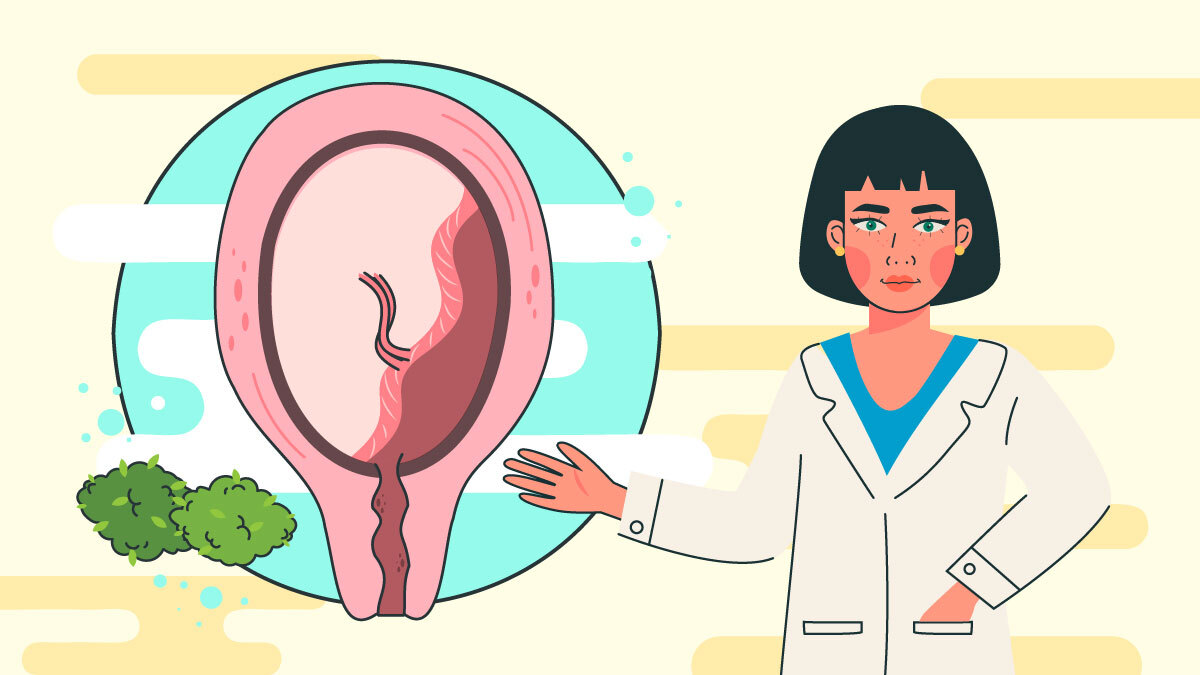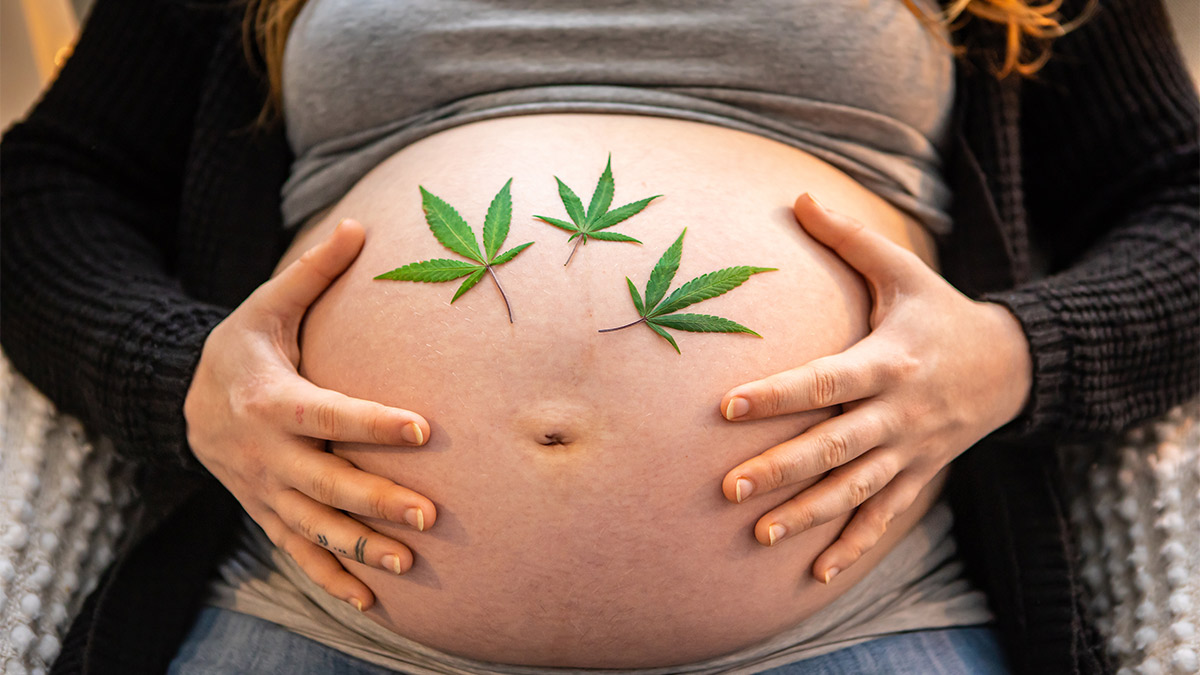How Long Does THC Stay In Your Placenta?

Few people would suggest that it’s a good idea to smoke weed when you’re pregnant. (If you’re in doubt, check with your obstetrician/gynecologist.)
But it’s happening more than ever. The National Survey on Drug Use and Health reports that between 2012 and 2017, the number of pregnant women using cannabis more than doubled.
Overall, the number of pregnant smokers increased from 3.4% to 7% during that period. And the number who used weed during their first trimester (when some may not have known they were expecting) increased from 5.7% to 12.1%
After a baby is born, doctors examine the placenta. Can it show residual signs of the mother’s weed use, possibly leading to legal complications? Let’s find out.
Weed and Pregnancy
A review published in the British Medical Journal summarized some of the findings about the effects a mother’s weed use can have on their new baby. It found that using cannabis during pregnancy was more likely to lead to lower birth weight, and to an increased chance that the infant would have to be placed in an intensive care unit. The researchers did emphasize, though, that many of the mothers studied may also have smoked cigarettes or used alcohol as well.
The Center for Women’s Mental Health at Massachusetts General Hospital reports that a mother’s cannabis use can affect embryo development as well. THC interferes with the production of folic acid, which can cause brain and spine defects in the fetus, as well as low birth weight. The cannabinoid may interfere with neural and brain development, and normal cellular growth.
There are also implications for the mother. Folic acid deficits can cause spontaneous abortions, and weed use can lead to an increased risk of a stillborn baby.
Where does the placenta figure in? Nourishment is passed from the mother to the fetus, of course, through the placenta. And THC and its metabolites are able to cross the placenta to enter the fetus’s blood and reach the brain. Animal models indicate that fetal THC levels are about 10% of the mother’s after she smokes up. Traces of THC remain in the placenta as well.
Maybe you knew some or all of that. Maybe it’s new to you, and you’re rethinking things. Or maybe you don’t think it really matters all that much.
In the first or third cases, you’re probably reading this because you’re concerned about drug testing after your baby is born.
If your worry is whether your newborn baby might test positive for weed — and what could happen next — read on.
Pregnant Women, New Mothers, and Weed
Anyone who’s been pregnant knows that urine samples are taken during prenatal visits. Those samples aren’t usually checked for cannabis; they’re used to check for health issues that could endanger the baby or the mother. However, if the doctor suspects drug use, the urine could be also be used to do a drug test.
That’s not a small issue. Fifteen states require health care workers to report suspected drug abuse during pregnancy to state officials. And in many states, substance abuse during pregnancy is considered child abuse or child neglect. In Tennessee, it’s a crime. Whether weed use falls into that category is up to each state.
In fact, a case currently being considered in Arizona involves a medical marijuana patient who was charged with child abuse after smoking medical cannabis while pregnant. Legal battles over the case continue, but she’s been placed on the state’s child abuse registry — even though medical and recreational use is legal in Arizona.
Prenatal visits are one issue to think about, but this might be the bigger concern for new mothers who have used cannabis during pregnancy: tests are routinely conducted on a baby after it’s born.
Newborn Babies and Weed Tests

When a baby is 24 hours old, a “newborn screening” blood test (called the Recommended Uniform Screening Panel) is performed. However, it’s not to look for drugs. It’s to check for genetic disorders and rare diseases.
Of more concern to mothers who’ve used, though, are meconium (the baby’s first poop), placenta, and umbilical cord tests.
The placenta routinely receives a visual examination after birth, but not to look for drugs; it’s to make sure all of it was removed, and that there is no infection. But further tests on the placenta, meconium, or umbilical cord can show evidence of the mother’s drug use.
Most states don’t require that mothers and babies be drug tested after birth. However, two (North Dakota and Minnesota) do require it if there are drug-related complications during birth, and others mandate testing if the mother has a documented substance abuse problem.
Hospital personnel are also likely to order testing if they suspect (or know) that the mother has been using, and a growing number of hospitals have mandated at least one of those tests after all births, because of the nation’s opiate epidemic.
In short, there’s no universal standard for which test will be performed, or whether any of them will be.
If they are done, here’s what they can show:
- Meconium: Evidence of drug use, including weed, can be detected from the past 4-5 months.
- Umbilical cord: It may take babies 24 hours or longer to pass stool, and they may have passed their first stool while still in the uterus. For that reason, some hospitals test the umbilical cord for signs of drug use instead. The test can detect cannabis, opiate, cocaine, PCP, and meth use during the third trimester.
- Placenta: A drug test with tissue from the placenta is the least reliable approach because experts aren’t sure exactly how far back in the pregnancy drug use will show up. Some opiates can be detected for months, but evidence of other drug use may only reflect the past few days. It’s believed the relevant time frame for detecting cannabis is about the same as it is for the umbilical cord, but that hasn’t been proven.
If any of those tests show that the mother has used weed during her pregnancy, what’s next?
Potential Consequences of a Newborn’s Positive Weed Test
The first thing that usually happens after the baby tests positive is that it will be isolated, to ensure that there are no negative effects from drug exposure or withdrawal. Unless the infant is ill, that period only lasts 24-48 hours. The mother will be drug tested as well.
After that, it’s up to the hospital, doctor, and state laws.
If the only substance that showed on the baby’s drug test was marijuana and the mother is clean, the worst consequence in most states is that the state’s department of child protective services will be notified.
That doesn’t mean they’ll take the baby away; that’s a rare occurrence. In most cases, CPS will simply keep the information on file, and an official may pay the mother a visit to ensure the child will be raised in a safe environment. The mother may also be required to undergo regular drug screenings.
There are three important facts to remember, though. One is that most officials will treat evidence of the mother’s weed use — an infant’s prenatal test — differently than evidence of drug abuse. Another is that they’ll be likely to treat a positive test for weed differently than a positive test for a “real” drug of abuse.
Finally, however, remember that every state treats cannabis very differently. None will condone the use of marijuana while pregnant, because of the very real harm it can do. And some may go easy on mothers when their newborn tests positive for cannabis. But others may deal with the situation harshly — even, as we’ve mentioned, in states like Arizona where weed is legal.
How Long Does Weed Stay in Your Placenta: FAQ
Q: Don’t they need permission to give your baby a drug test?
A: Actually, they don’t. Once the baby has been born, you no longer have the right to refuse placenta, meconium, or umbilical cord testing. You can only refuse a drug test for yourself.
Q: I thought it was up to the parents whether the placenta was tested?
A: Placenta testing is optional, and up to the mother/parents, if it’s being done to check for genetic defects or other disorders. If it’s to look for signs of drug use, though, that’s up to hospital personnel in accordance with state law.
Q: If weed use only shows up in the placenta and elsewhere for 4-5 months at most, does that mean you should stop using after the first trimester?
A: If you’re only concerned with being “caught,” probably. But if you’re concerned about the baby’s health and safety (as well as your own), you should put down the pipe as soon as you know you’re pregnant.
References
- Volkow, N. D., Han, B., Compton, W. M., & McCance-Katz, E. F. (2019). Self-reported medical and nonmedical cannabis use among pregnant women in the United States. Jama, 322(2), 167-169. [1]
- Gunn, J. K. L., Rosales, C. B., Center, K. E., Nuñez, A., Gibson, S. J., Christ, C., & Ehiri, J. E. (2016). Prenatal exposure to cannabis and maternal and child health outcomes: a systematic review and meta-analysis. BMJ open, 6(4), e009986. [2]
- Varner, M. W., Silver, R. M., Hogue, C. J. R., Willinger, M., Parker, C. B., Thorsten, V. R., … & Eunice Kennedy Shriver National Institute of Child Health. (2014). Association between stillbirth and illicit drug use and smoking during pregnancy. Obstetrics and gynecology, 123(1), 113. [3]
- Committee on Obstetric Practice. (2017). Committee opinion no. 722: marijuana use during pregnancy and lactation. Obstetrics and gynecology, 130(4), e205-e209. [4]
- Maynard, E. C., Amoruso, L. P., & Oh, W. (1991). Meconium for drug testing. American Journal of Diseases of Children, 145(6), 650-652.
- Montgomery, D. P., Plate, C. A., Jones, M., Jones, J., Rios, R., Lambert, D. K., … & Christensen, R. D. (2008). Using umbilical cord tissue to detect fetal exposure to illicit drugs: a multicentered study in Utah and New Jersey. Journal of Perinatology, 28(11), 750-753.[6]
- Price, H. R., Collier, A. C., & Wright, T. E. (2018). Screening pregnant women and their neonates for illicit drug use: consideration of the integrated technical, medical, ethical, legal, and social issues. Frontiers in pharmacology, 9, 961. [7]